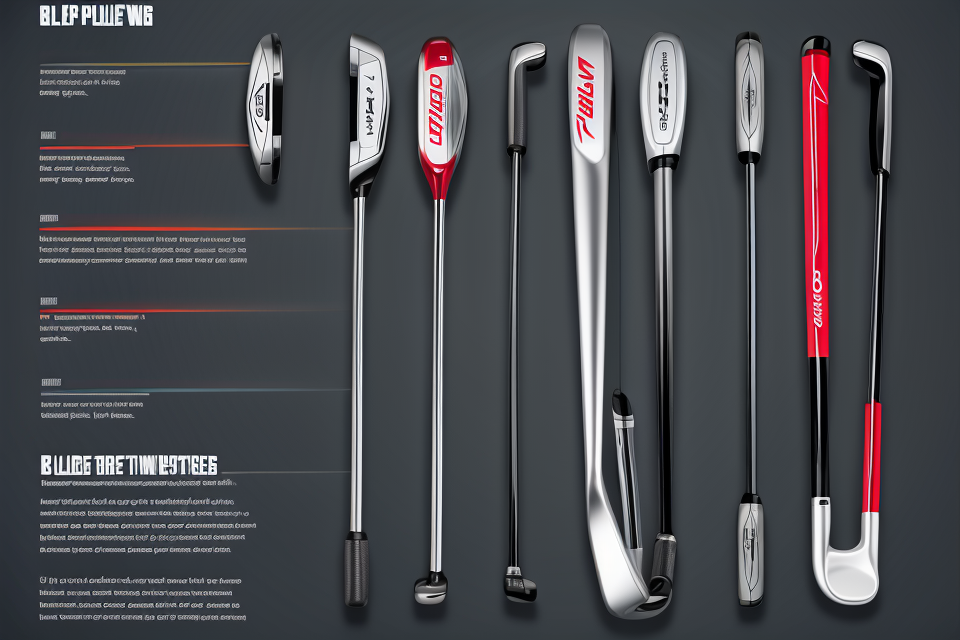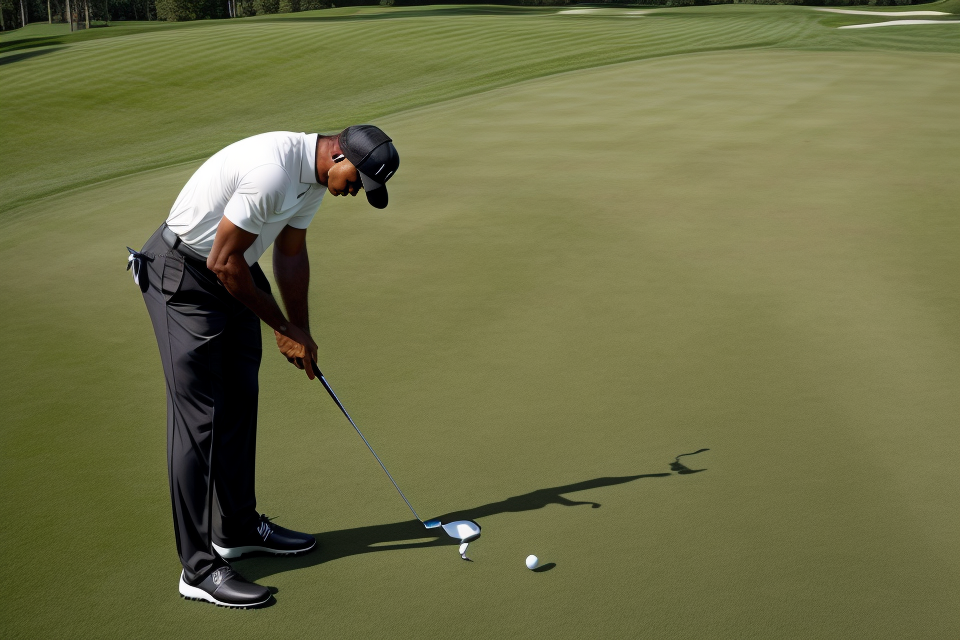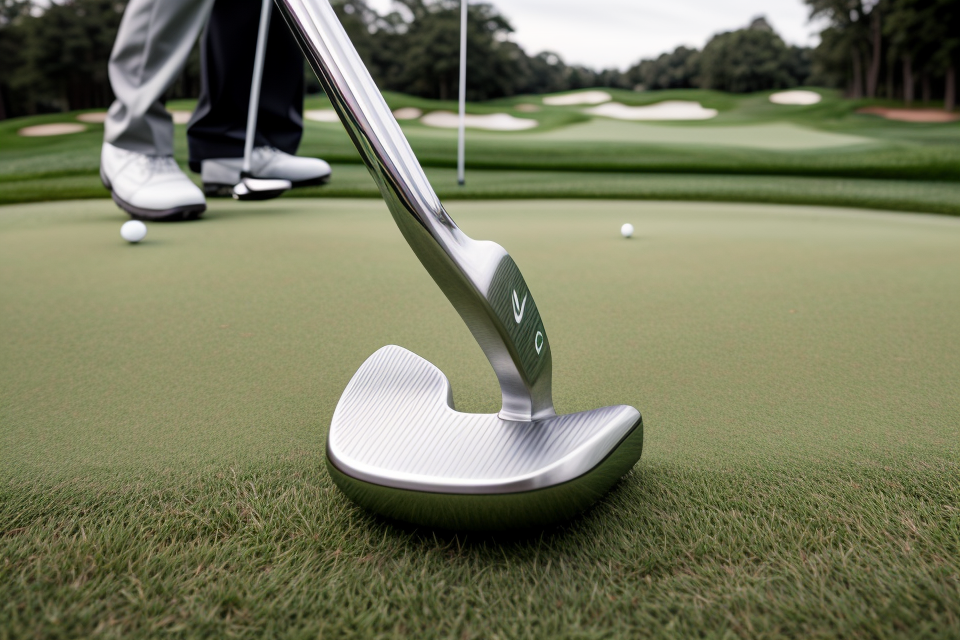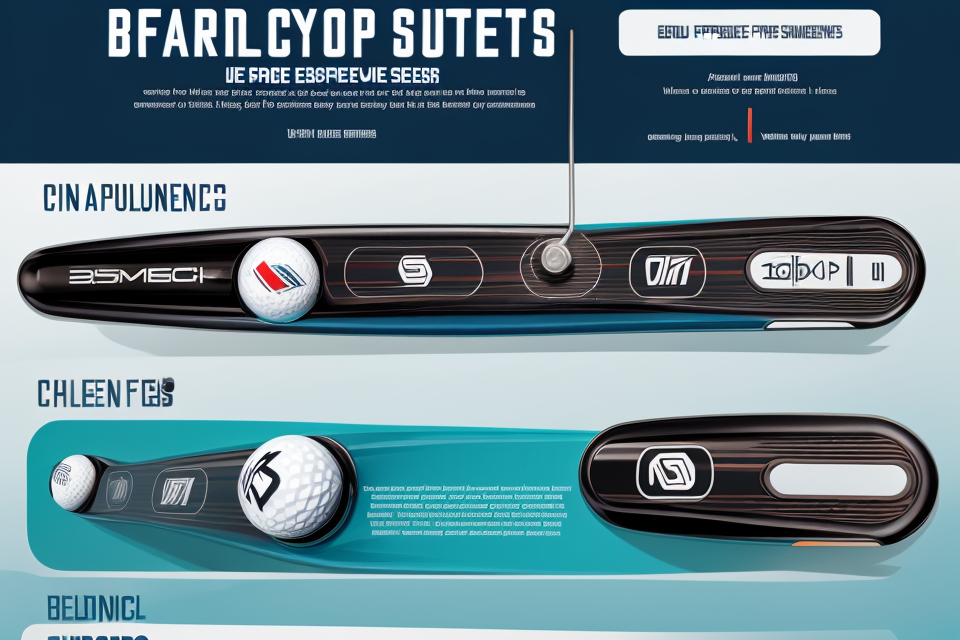
Golfers are a peculiar bunch, with their own lingo and terminology. And when it comes to putters, they have two main types to choose from – the blade putter and the mallet putter. But what’s the difference between the two? Well, the blade putter is a sleek and slender club, with a thin face and a narrow head. It’s the traditional choice for golfers who prefer a more classic look and feel. On the other hand, the mallet putter is a more modern design, with a larger head and a more forgiving face. It’s a popular choice for golfers who struggle with accuracy and need a bit more help on the greens. So, which one should you choose? Read on to find out!
A blade putter and a mallet putter are two different types of golf clubs used for putting. A blade putter has a thin, flat head that is designed to move through the air smoothly and create a consistent roll on the golf ball. A mallet putter, on the other hand, has a larger, more rounded head that is designed to provide more stability and forgiveness on off-center hits. The blade putter is typically used by golfers with a more precise and controlled putting stroke, while the mallet putter is often preferred by golfers who want more forgiveness and stability in their putting stroke.
What is a Blade Putter?
Characteristics of a Blade Putter
- Designed for a more skilled golfer: Blade putters are designed for golfers who have a high level of skill and precision in their strokes. These putters are typically used by professionals and low handicap golfers who can control the ball’s trajectory and speed with ease.
- Fewer degrees of loft: Unlike mallet putters, blade putters have a lower degree of loft, which means that the ball is launched on a lower, more direct path. This is ideal for golfers who prefer a more consistent ball flight and accuracy.
- A sleeker, more streamlined look: Blade putters have a sleek, streamlined design that is typically more compact and lightweight than mallet putters. This design allows for more precise and controlled strokes, making it easier to hit the sweet spot of the ball.
- Generally lower in weight: Blade putters are typically lighter in weight than mallet putters, which makes them easier to swing and control. This is particularly beneficial for golfers who prefer a more rapid swing speed and prefer to generate power through their strokes.
- Requires more precise and controlled strokes: Due to their design, blade putters require a more precise and controlled stroke to hit the ball accurately. This can be challenging for golfers who are not used to this type of putter, but with practice, it can lead to more accurate and consistent putting.
Pros and Cons of Using a Blade Putter
Pros:
- More control: A blade putter is designed with a thin, lightweight blade-shaped head that provides a more direct and precise stroke, giving golfers better control over the ball’s direction and distance.
- Precision: The slender design of the blade putter allows for a more precise stroke, making it easier to hit the ball accurately and avoid significant mistakes such as slice or hook.
- Feel: Many golfers prefer the feel of a blade putter, as it allows for a more natural and fluid stroke, which can enhance their overall performance and confidence on the green.
Cons:
- Requires more skill: Using a blade putter requires a higher level of skill and control, as it demands precise hand-eye coordination and a steady hand. This can make it challenging for some golfers, particularly those who are less experienced or have slower swing speeds.
- May not be suitable for all golfers: Blade putters are generally better suited for golfers with a steady hand and a consistent stroke, as they may not be as forgiving for those who struggle with accuracy or have a tendency to mishit the ball. For some golfers, a mallet putter or other types of putters may be a better option.
What is a Mallet Putter?
Characteristics of a Mallet Putter
A mallet putter is a type of golf club that is designed for golfers with slower swing speeds. It is characterized by its higher degrees of loft, which makes it easier to lift the ball and roll it towards the hole. Additionally, the mallet putter has a more forgiving design, which means that it is less sensitive to off-center hits.
One of the main advantages of a mallet putter is that it is often heavier in weight, which helps to stabilize the clubhead during the swing. This can be particularly beneficial for golfers who struggle with slow or erratic putting strokes. The heavier weight of the mallet putter also helps to reduce the amount of hand action required during the stroke, which can improve the consistency and accuracy of the putt.
Another characteristic of a mallet putter is that it requires less precise and controlled strokes. This is because the higher degrees of loft and the more forgiving design of the club make it easier to keep the ball on line and roll it towards the hole, even if the stroke is not perfectly controlled. This can be particularly helpful for golfers who struggle with the precision required for accurate putting.
Overall, the mallet putter is a versatile and forgiving option for golfers with slower swing speeds who are looking for a putter that is easy to use and offers a high degree of forgiveness. Its higher degrees of loft, more forgiving design, and heavier weight make it a popular choice for many golfers, particularly those who struggle with accuracy and consistency on the green.
Pros and Cons of Using a Mallet Putter
- Easier to use: Mallet putters are generally more forgiving and easier to use compared to blade putters, making them suitable for golfers with slower swing speeds or those who are new to the game.
- More forgiving: Mallet putters have a larger sweet spot and a more forgiving design, which means that even if you don’t hit the ball perfectly, you can still make a decent shot.
-
Suitable for golfers with slower swing speeds: Mallet putters are often recommended for golfers with slower swing speeds because they provide more stability and control during the swing.
-
Less control: Mallet putters are generally less precise than blade putters, which means that you may have less control over the direction and speed of your shots.
- Less precision: Due to their larger size and weight, mallet putters can be less precise than blade putters, which may make it harder to make delicate adjustments to your shots.
- Less feel: Some golfers find that mallet putters don’t provide as much feedback or feel as blade putters, which can make it harder to gauge the speed and direction of your shots.
Choosing the Right Putter for Your Game
Factors to Consider
When it comes to choosing the right putter for your game, there are several factors to consider. These factors include your swing type, skill level, personal preferences, and course conditions. Let’s take a closer look at each of these factors.
- Your swing type: One of the most important factors to consider when choosing a putter is your swing type. If you have a slow, smooth swing, a blade putter may be a good choice for you. On the other hand, if you have a faster, more unstable swing, a mallet putter may be a better option.
- Your skill level: Another important factor to consider is your skill level. If you are a beginner or have a less consistent stroke, a mallet putter may be a better choice as it provides more stability and forgiveness. However, if you are a more experienced player with a consistent stroke, a blade putter may offer more control and precision.
- Your personal preferences: Personal preferences also play a role in choosing the right putter. Some golfers prefer the classic look and feel of a blade putter, while others prefer the modern design and technology of a mallet putter. It’s important to choose a putter that not only performs well but also feels comfortable and enjoyable to use.
- Course conditions: The course conditions can also impact your choice of putter. If you frequently play on soft, wet courses, a mallet putter with a larger sweet spot may be more forgiving. However, if you play on fast, dry courses, a blade putter may offer more control and precision on shorter putts.
By considering these factors, you can make an informed decision about which type of putter is best for your game. Whether you choose a blade putter or a mallet putter, the most important thing is to find a putter that feels comfortable and helps you sink more putts.
Tips for Selecting the Right Putter
Selecting the right putter is crucial for improving your golf game. Here are some tips to help you choose the right putter for your game:
Try out different putters
Trying out different putters is the best way to find the right one for your game. Most golf stores offer a putting green where you can test different putters before making a purchase. It’s essential to test putters with different shapes, sizes, and weights to determine which one feels comfortable in your hands.
Pay attention to the feel and balance
The feel and balance of a putter are critical factors to consider when selecting the right one. A well-balanced putter will allow you to make more accurate shots, and the right feel will help you develop a consistent stroke. It’s important to pay attention to the balance point of the putter and ensure it’s aligned with your eyes.
Consider the look and style
While the look and style of a putter may seem insignificant, it can affect your performance on the golf course. Choose a putter that has a style that suits your personality and one that you’re comfortable using. A putter with a sleek design or unique color can help you stand out on the golf course and boost your confidence.
Consult with a golf professional
Consulting with a golf professional is a great way to get advice on selecting the right putter. A golf professional can help you assess your putting stroke and recommend a putter that suits your style. They can also offer tips on how to improve your putting technique and help you develop a consistent stroke.
FAQs
1. What is a putter in golf?
A putter is a golf club used to hit the golf ball into the hole from a short distance, typically on the green. It has a flat bottomed, mallet-shaped head and a shaft with a grip.
2. What is the difference between a blade putter and a mallet putter?
A blade putter has a more sleek and streamlined shape, with a thinner and more rounded head than a mallet putter. Blade putters are generally used by golfers with a more straight-back, straight-through stroke, and they tend to be more forgiving on mishits. On the other hand, a mallet putter has a larger, more rounded head with a more flat face, making it more forgiving on off-center hits. Mallet putters are often used by golfers with an arc-style stroke.
3. What are the advantages of using a blade putter?
A blade putter provides golfers with a more feel-based experience, as the head shape and design allows for more control over the ball’s path and roll. It is also typically lighter than a mallet putter, making it easier to handle and control.
4. What are the advantages of using a mallet putter?
A mallet putter is generally more forgiving than a blade putter, as the larger head size and flat face provide a more stable and consistent impact. This makes it a good choice for golfers who struggle with accuracy or have a less consistent stroke. Mallet putters also tend to be heavier than blade putters, which can help with the stability of the putter during the stroke.
5. What are some factors to consider when choosing a putter?
When choosing a putter, it is important to consider your personal style and preferences, as well as your skill level and the type of stroke you use. Other factors to consider include the length and weight of the putter, the material it is made of, and the design of the head and shaft. It is also important to consider the overall feel and balance of the putter in your hands.


